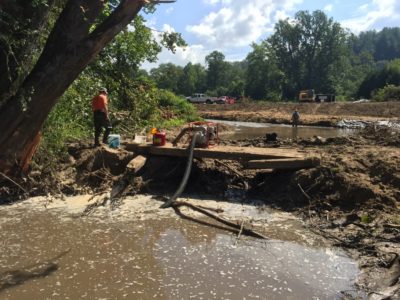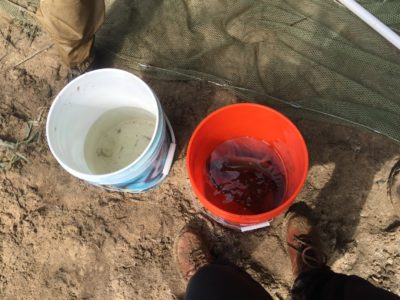East Fork Restoration
Neighbors Unite to Restore a Dividing River

“I would like to make that my home one day,” Woody Platt would say, whenever he passed by the white 1930s farmhouse nestled between rolling hills with the East Fork of the French Broad River winding behind it. Platt, an avid life-long angler, admired the land’s access to trout-filled waters. It is a pastoral property that brings a quiet sense of peace to balance Platt’s busy career as a member of the Grammy award-winning bluegrass band, Steep Canyon Rangers.
Platt made that dream a reality when he and his wife and fellow musician, Shannon Whitworth, purchased the property in 2010. “This whole East Fork Valley has a very rural feel, a lot of open farmland and a lot of water,” shares Platt. “I was just really drawn to the river and to have this old farmhouse on some open pastureland—it’s pretty wonderful.”
But, like most good things, land is a work in progress. Platt and Whitworth knew that their beloved river was struggling to stay healthy.
During times of heavy rainfall, large chunks of riverbank slid into the water and heavy sediment built up, choking the rare plants and wildlife that live in the river.
“I’ve seen 10 to 20 feet erode into the stream in several locations. Any time we would get a lot of rain, the water would immediately be muddy in color and you would see large clumps of sand just falling off the bank,” says Platt.
Platt and Whitworth, along with their neighbors across the river, Carl and Lois Ganner, knew something needed to be done to save the integrity of the riverbanks and the quality of the water. The Ganners operate Z-Z-Zip Canopy Tours, a zip-line adventure business, on their property. Making sure their land is healthy is important in protecting those aerial views when clients are soaring overhead.

This area along the East Fork lacked natural vegetation that helps hold soil in place along the floodplain and the riverbanks. Historic ranching operations removed the native plants and trees, replacing them with non-native grasses for livestock that have shallow roots and are unable to hold soil well during higher river flows.
All rivers are in a constant state of flux, shares Torry Nergart, Conservation Easement Manager at Carolina Mountain Land Conservancy. “Unfortunately, they also do not follow deeded private property rights. The river was oxbowing and would have eventually formed a new channel. This erosion would have created a loss of acreage for Platt, Whitworth and the Ganners, as well as impact all wildlife. Both landowners are conservation-minded, and did not want to just sit by and let the river keep on taking away sediment.”
Platt, Whitworth and the Ganners jumped into action, rounding up the necessary parties to make restoration possible.
“When the Platt’s came to me about this project, I knew that it would be a good fit for the Western NC Stream Initiative,” says Emily Pohlman with USDA-NRCS. “Through the Western NC Stream Initiative, NRCS is able to offer financial assistance to agricultural producers to implement stream restoration projects like this.”
Carolina Mountain Land Conservancy was a key fundraising player, securing lead grants that private landowners cannot access on their own from the North Carolina Clean Water Management Trust Fund and the U.S. Fish and Wildlife Service.
Before restoration work began, the U.S. Fish and Wildlife Service relocated aquatic species from the water for protection, including seven Hellbenders, one freshwater leech and several trout. The Hellbenders were a significant and surprising discovery, as they are a candidate for listing as Federally Endangered and weren’t previously documented in that section of the river.
The high riverbanks were excavated to reduce the bank height from 10 feet to about 2.5 feet. Willows and alders were planted. The most severe meander was re-aligned to have a gentler curve. Root wads (dead tree trunks with their roots still intact) and tree limbs were buried along the toes of the banks.
“These logs and root structures add excellent habitat features and help to maintain proper pool depths,” says Grant Ginn with Wolf Creek Engineering, who designed and oversaw construction of the restoration project. “Additionally, the reshaping of the river bed profile provided the opportunity to reconstruct the riffles out of the native gravel and cobble that had been buried below years of silt and sand deposition.”
The East Fork, along with the North, West and Middle Forks, contain the headwaters of the French Broad. As the river flows, it is a source of agriculture irrigation and outdoor recreation, two major drivers of our local economy.

“People used to say the French Broad was ‘too thick to swim, too thin to plow’ for all the pollution and sedimentation,” says Nergart. “Nowadays, with some management, water quality has improved. The East Fork watershed is more than 60% protected by the newly forming Headwaters State Forest, sending clean mountain water downstream. That level of clean water means the threatened Hellbender salamander can call the East Fork home. Trout also require that same degree of oxygen-rich, sediment-free cold water.”
After the two-month restoration work was completed last fall, the river has made a significant rebound.
“We’re watching it every day,” says Platt. “The water is running clear; you can really see the cobble and ripples again. The water now has some place to go; it’s not hitting a wall. In high water it naturally swells up and flows back down. You can see the health of the stream coming back.”
Platt, Whitworth and the Ganners worked with Carolina Mountain Land Conservancy to permanently conserve the re-vegetated streambanks at the restoration site. Placing a voluntary conservation easement on the land ensures the important restoration work cannot be undone. The trees that were replanted along the stream to help stabilize the banks cannot be cut down nor can the riverbank be reshaped at the whims of a future landowner.
“NRCS values its partnership with conservation organizations like CMLC,” says Pohlman. “Without the collaborative efforts of all partners involved, this project would not have been possible.”

“If you’re going to work to stabilize a piece of property like this and try to restore it for the natural health, it makes a lot of sense to put a perpetual easement on it so the long-term health of the property is protected,” says Platt.
The project featured a lot of moving parts made successful by several partners including the Transylvania County Soil and Water Conservation District, Conservation Advisors of North Carolina, North State Environmental, Resource Institute, Natural Resources Conservation Service, Clean Water Management Trust Fund, U.S. Fish and Wildlife Service, NC Department of Justice Ecosystem Enhancement Grants Program, Wolf Creek Engineering and NC Division of Water Resources.
“Being able to come together with the Transylvania SWCD, CMLC and USFWS, as well as all the other partners, to bring a project like this to fruition is something that we are all very proud of,” says Pohlman.
Platt agrees everyone worked together really well. “I’m looking forward to working with Carolina Mountain Land Conservancy moving forward to maintain the conservation easement, making sure that everything stays healthy,” says Platt.
With cleaner water and happier trout, bets are Platt will be reaching for that fishing pole more often.
Author Katie Onheiber is communications and marketing manager with Conserving Carolina.